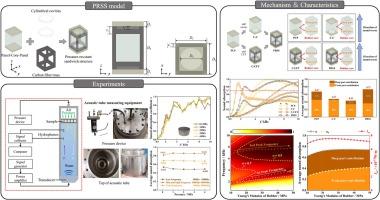Sound absorption mechanism and characteristic of a pressure-resistant sandwich structure supported by carbon fiber truss and embedded cavities in rubber core
IF 3.4
2区 物理与天体物理
Q1 ACOUSTICS
引用次数: 0
Abstract
This work presents a new underwater pressure-resistant sandwich structure (PRSS) that owns both well mechanical and acoustic properties. The two panels of PRSS are carbon fiber reinforced polymer (CFRP) and the core layer is made of the carbon fiber truss (CFT) and rubber matrix embedded with cavities. The test sample of PRSS is prepared and sound absorption coefficients are measured under various water pressures in the acoustic tube. Meanwhile, the finite element (FE) model of PRSS is established in the COMSOL to simulate its sound propagation behaviors in water. Gained experimental and numerical results have good agreements, which confirm the effectiveness of acoustic tube test and FE simulation. The experiment verifies the efficient sound absorption coefficient (≥0.7) of PRSS at the broadband frequency range (2800 Hz-10000 Hz) and also demonstrates its low sensitivity of sound absorption with respect to the change of pressure (0.1 MPa to 4 MPa). Then the sound absorption mechanism of PRSS is discussed through numerical analyses. It is found that there are two significant absorption peaks in the range of 500 Hz-10000 Hz. Besides, parameters effects on the two absorption peaks are characterized, revealing the critical “acoustic bridge” role of CFT in directing sound energy deeper into the structure and resulting in more dissipation.

由碳纤维桁架和橡胶芯嵌入空腔支撑的耐压夹层结构的吸音机理和特性
这项研究提出了一种新型水下抗压夹层结构(PRSS),它具有良好的机械性能和声学性能。水下抗压夹层结构的两层面板为碳纤维增强聚合物(CFRP),芯层由碳纤维桁架(CFT)和嵌入空腔的橡胶基体组成。制备了 PRSS 的测试样品,并在声学管中测量了不同水压下的吸声系数。同时,在 COMSOL 中建立了 PRSS 的有限元 (FE) 模型,以模拟其在水中的声传播行为。获得的实验结果和数值结果具有良好的一致性,证实了声管测试和有限元模拟的有效性。实验验证了 PRSS 在宽带频率范围(2800 Hz-10000 Hz)内的高效吸声系数(≥0.7),也证明了其吸声对压力变化(0.1 MPa 至 4 MPa)的低敏感性。然后,通过数值分析讨论了 PRSS 的吸声机理。结果发现,在 500 Hz-10000 Hz 范围内有两个明显的吸声峰。此外,参数对这两个吸声峰的影响也得到了表征,揭示了 CFT 在将声能引向结构深处并导致更多耗散方面的关键 "声桥 "作用。
本文章由计算机程序翻译,如有差异,请以英文原文为准。
求助全文
约1分钟内获得全文
求助全文
来源期刊

Applied Acoustics
物理-声学
CiteScore
7.40
自引率
11.80%
发文量
618
审稿时长
7.5 months
期刊介绍:
Since its launch in 1968, Applied Acoustics has been publishing high quality research papers providing state-of-the-art coverage of research findings for engineers and scientists involved in applications of acoustics in the widest sense.
Applied Acoustics looks not only at recent developments in the understanding of acoustics but also at ways of exploiting that understanding. The Journal aims to encourage the exchange of practical experience through publication and in so doing creates a fund of technological information that can be used for solving related problems. The presentation of information in graphical or tabular form is especially encouraged. If a report of a mathematical development is a necessary part of a paper it is important to ensure that it is there only as an integral part of a practical solution to a problem and is supported by data. Applied Acoustics encourages the exchange of practical experience in the following ways: • Complete Papers • Short Technical Notes • Review Articles; and thereby provides a wealth of technological information that can be used to solve related problems.
Manuscripts that address all fields of applications of acoustics ranging from medicine and NDT to the environment and buildings are welcome.
 求助内容:
求助内容: 应助结果提醒方式:
应助结果提醒方式:


